Transmittance of Tapered Photonic Crystal Fibers with Absorbing Coatings
Mauricio Salazar Sicacha1, Vladimir P Minkovich1*, Alexander B Sotsky2, Artur V Shilov2, Luidmila I. Sotskaya3
1Centro de Investigaciones en Optica, A.C., Division of Photonics, León 37150, GTO, Mexico
2Mogilev State A. Kuleshov University, 212009, Mogilev, Belarus
3Belarussian-Russian University, 212000, Mogilev, Belarus
*Corresponding author: Vladimir P Minkovich, Centro de Investigaciones en Optica, A.C., Division of Photonics, León 37150, GTO, Mexico.
Received: 21 September 2022; Accepted: 10 October 2022; Published: 04 November 2022
Article Information
Citation: Mauricio Salazar Sicacha, Vladimir P Minkovich, Alexander B Sotsky, Artur V Shilov, Luidmila I. Sotskaya. Transmittance of Tapered Photonic Crystal Fibers with Absorbing Coatings. Journal of Nanotechnology Research 4 (2022): 125-129.
DOI: 10.26502/jnr.2688-85210035
View / Download Pdf Share at FacebookAbstract
The interaction effect of the fundamental mode of a Photonic Crystal Fiber (PCF) with a thin-film absorbing coating deposited on a surface of a fiber cladding on the optical transmission of the PCF is studied. It is shown that the transmission has a quasi-periodic spectrum that is determined either by a resonance coupling between the leaky fundamental PCF mode and leaky modes of the coating, or between the leaky fundamental PCF mode and cladding modes localized between PCF air channels and the coating. Examples are presented of using this effect for fiber-optic sensors of refractive index, pressure, and for sensing an adsorption layer of ammonia molecules deposited on a coating surface contacting with air.
Keywords
Optical fiber devices; Optical fiber sensors; Optical fiber taper; Photonic crystal fibers
Optical fiber devices articles Optical fiber devices Research articles Optical fiber devices review articles Optical fiber devices PubMed articles Optical fiber devices PubMed Central articles Optical fiber devices 2023 articles Optical fiber devices 2024 articles Optical fiber devices Scopus articles Optical fiber devices impact factor journals Optical fiber devices Scopus journals Optical fiber devices PubMed journals Optical fiber devices medical journals Optical fiber devices free journals Optical fiber devices best journals Optical fiber devices top journals Optical fiber devices free medical journals Optical fiber devices famous journals Optical fiber devices Google Scholar indexed journals Optical fiber sensors articles Optical fiber sensors Research articles Optical fiber sensors review articles Optical fiber sensors PubMed articles Optical fiber sensors PubMed Central articles Optical fiber sensors 2023 articles Optical fiber sensors 2024 articles Optical fiber sensors Scopus articles Optical fiber sensors impact factor journals Optical fiber sensors Scopus journals Optical fiber sensors PubMed journals Optical fiber sensors medical journals Optical fiber sensors free journals Optical fiber sensors best journals Optical fiber sensors top journals Optical fiber sensors free medical journals Optical fiber sensors famous journals Optical fiber sensors Google Scholar indexed journals Optical fiber taper articles Optical fiber taper Research articles Optical fiber taper review articles Optical fiber taper PubMed articles Optical fiber taper PubMed Central articles Optical fiber taper 2023 articles Optical fiber taper 2024 articles Optical fiber taper Scopus articles Optical fiber taper impact factor journals Optical fiber taper Scopus journals Optical fiber taper PubMed journals Optical fiber taper medical journals Optical fiber taper free journals Optical fiber taper best journals Optical fiber taper top journals Optical fiber taper free medical journals Optical fiber taper famous journals Optical fiber taper Google Scholar indexed journals Photonic crystal fibers articles Photonic crystal fibers Research articles Photonic crystal fibers review articles Photonic crystal fibers PubMed articles Photonic crystal fibers PubMed Central articles Photonic crystal fibers 2023 articles Photonic crystal fibers 2024 articles Photonic crystal fibers Scopus articles Photonic crystal fibers impact factor journals Photonic crystal fibers Scopus journals Photonic crystal fibers PubMed journals Photonic crystal fibers medical journals Photonic crystal fibers free journals Photonic crystal fibers best journals Photonic crystal fibers top journals Photonic crystal fibers free medical journals Photonic crystal fibers famous journals Photonic crystal fibers Google Scholar indexed journals geometric articles geometric Research articles geometric review articles geometric PubMed articles geometric PubMed Central articles geometric 2023 articles geometric 2024 articles geometric Scopus articles geometric impact factor journals geometric Scopus journals geometric PubMed journals geometric medical journals geometric free journals geometric best journals geometric top journals geometric free medical journals geometric famous journals geometric Google Scholar indexed journals environment articles environment Research articles environment review articles environment PubMed articles environment PubMed Central articles environment 2023 articles environment 2024 articles environment Scopus articles environment impact factor journals environment Scopus journals environment PubMed journals environment medical journals environment free journals environment best journals environment top journals environment free medical journals environment famous journals environment Google Scholar indexed journals molecules articles molecules Research articles molecules review articles molecules PubMed articles molecules PubMed Central articles molecules 2023 articles molecules 2024 articles molecules Scopus articles molecules impact factor journals molecules Scopus journals molecules PubMed journals molecules medical journals molecules free journals molecules best journals molecules top journals molecules free medical journals molecules famous journals molecules Google Scholar indexed journals liquids articles liquids Research articles liquids review articles liquids PubMed articles liquids PubMed Central articles liquids 2023 articles liquids 2024 articles liquids Scopus articles liquids impact factor journals liquids Scopus journals liquids PubMed journals liquids medical journals liquids free journals liquids best journals liquids top journals liquids free medical journals liquids famous journals liquids Google Scholar indexed journals absorbing polymer articles absorbing polymer Research articles absorbing polymer review articles absorbing polymer PubMed articles absorbing polymer PubMed Central articles absorbing polymer 2023 articles absorbing polymer 2024 articles absorbing polymer Scopus articles absorbing polymer impact factor journals absorbing polymer Scopus journals absorbing polymer PubMed journals absorbing polymer medical journals absorbing polymer free journals absorbing polymer best journals absorbing polymer top journals absorbing polymer free medical journals absorbing polymer famous journals absorbing polymer Google Scholar indexed journals leaky articles leaky Research articles leaky review articles leaky PubMed articles leaky PubMed Central articles leaky 2023 articles leaky 2024 articles leaky Scopus articles leaky impact factor journals leaky Scopus journals leaky PubMed journals leaky medical journals leaky free journals leaky best journals leaky top journals leaky free medical journals leaky famous journals leaky Google Scholar indexed journals
Article Details
1. Introduction
It is known that the fundamental mode of a Photonic-Crystal Fiber (PCF) can be resonance coupled with modes of a thin film PCF coating [1]. If the coating is absorbing, the coupling leads to a quasi-periodic spectral transmittance of the PCF that can be modified by interaction of coating modes with environment. This effect is explained by the coupling of leaky modes of the PCF core and the coating [1] and does not require close contact between the core and the coating, as it is in the case of fiber-optic sensors with lossy mode resonances [2, 3]. But when using untapered PCFs, the mentioned coupling of leaky modes can be rather weak. As a result, it can only be observed when sufficiently long stretches (tens of centimeters) of coated PCFs are used. Besides, to realize corresponding sensory effects it is necessary to keep the coating thickness d constant along the entire sensitive stretch of the PCF with a tolerance of  is a light wavelength, nc and ns are refractive indexes of the coating and a fiber cladding, respectively [1]. For long PCF stretches this requirement is difficult to fulfil. It is hoped that the use of adiabatic PCF tapers with a length of a sensitive region (taper waist) of a centimeter order will overcome these difficulties. But due to a small transverse size of the taper waist, an interaction of the fundamental PCF mode with the absorbing coating of the taper waist has special features that are considered in this paper. Corresponding estimates are presented for transmission spectra of PCF tapers at sensing refractive index of a liquid, pressure in the liquid and an adsorption nanoscale layer. Numerical simulations of PCFs modal properties are performed with the use of the exact method of integral equations [1].
is a light wavelength, nc and ns are refractive indexes of the coating and a fiber cladding, respectively [1]. For long PCF stretches this requirement is difficult to fulfil. It is hoped that the use of adiabatic PCF tapers with a length of a sensitive region (taper waist) of a centimeter order will overcome these difficulties. But due to a small transverse size of the taper waist, an interaction of the fundamental PCF mode with the absorbing coating of the taper waist has special features that are considered in this paper. Corresponding estimates are presented for transmission spectra of PCF tapers at sensing refractive index of a liquid, pressure in the liquid and an adsorption nanoscale layer. Numerical simulations of PCFs modal properties are performed with the use of the exact method of integral equations [1].
1.1. Operating mechanism
The structure under investigation is presented in Figure 1. Calculations are performed for a PCF consisted of a solid core surrounded by three rings of air holes arranged in a hexagonal pattern. The PCFs material is a quartz glass. The cladding diameter of PCF D0=123.4μm, the diameter of air holes a0=3μm, the photonic crystal pitch ∧0=8.8μm [4]. At the adiabatic taper fabrication, the diameter of ho∧es a and the pitch ∧ within the taper waist modify by the rule [5] a=(2Aw/D0) a0, ∧=(2Aw/D0)∧0. In taper calculations we used values 2Aw=44μm and ∧ =3cm [3] (see Figure 1).
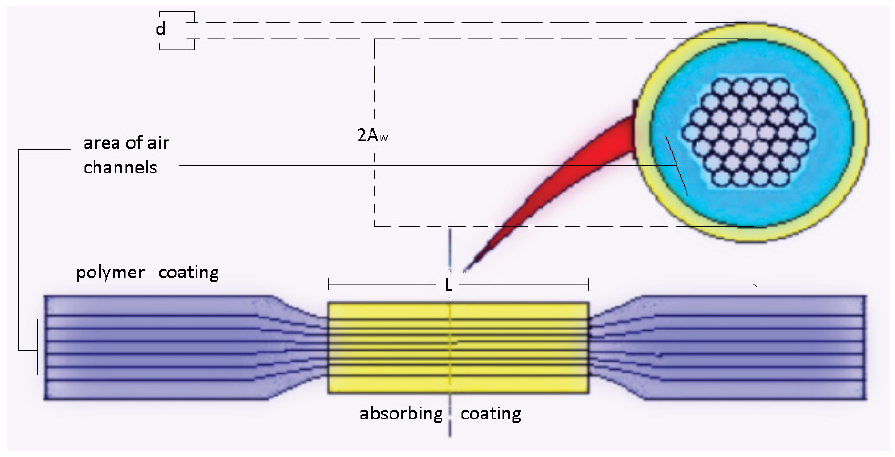
Figure 1: An adiabatic taper of a PCF with three hexagonal rings of air channels and an absorbing coating with length L and thickness d around the taper waist of diameter 2Aw.
Figure 2 illustrates modal dispersion β(λ), where β is a dimensionless mode propagation constant, for PCFs coated with a multifunctional butyl acrylate having the complex refractive index nc=1.54-i0.00002 and surrounded with water  . In Figure 2 ‘phase index’ means
. In Figure 2 ‘phase index’ means  , where λ is taken in µm. Curves 3-6 in Figure 2 are results of a numerical solution by the contour integration method [6] of a dispersion equation for guide and leaky modes of a planar dielectric waveguide [7].
, where λ is taken in µm. Curves 3-6 in Figure 2 are results of a numerical solution by the contour integration method [6] of a dispersion equation for guide and leaky modes of a planar dielectric waveguide [7].
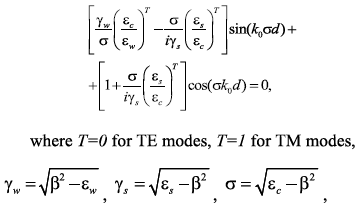
modeling the absorbing coating of thickness d.
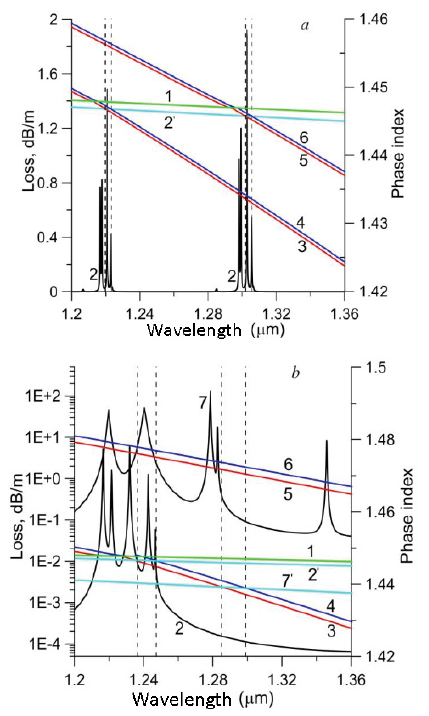
Figure 2: Spectral dependencies of mode propagation constants for straight and tapered PCFs with a polymer coating of thickness d=20μm (a) and d=5μm (b). Curves 2, 2’ and 7, 7’ are loss and a phase index of the PCF fundamental mode with 2Aw=D0 and 2Aw=44μm, respectively; curves 1 (right axes) refer to the silica refractive index; curves 3 - 6 are phase indexes of modes for absorbing coatings; curves 3, 5 refer to TM modes, 4, 6 - to TE modes. Dashed lines indicate intersection points of curves corresponding to index matching of PCF modes and the absorbing coatings.
Curves 3 -6 in Figure 2 are computed basing on the reasons that from the point of view of geometric optics the fundamental mode of the PCF is mainly formed by meridional rays [1]. When considering a reflection of such rays from the coating, the latter can be approximately replaced by a plane-parallel layer of thickness d. In this approximation, the coating modes should be understood as the modes of a plane dielectric waveguide. In Figure 2 segments of curves 3 - 6 located above the curve 1 correspond to guide modes, and below curve 1 - to leaky modes. At the same time, curves 2’ and 7’ pass everywhere below curve 1. So, the PCF fundamental mode always is leaky. As a result, its propagation constant can be matched with only leaky modes of the coating at wavelengths indicated in Figure 2 by vertical dashed lines. In Figure 2a the loss of the fundamental mode for the untapered (regular) PCF with the 20µm polymer coating sharply grows in the close vicinity of these wavelengths. This means that observed in Figure 2a a quasi-periodic spectrum of the fundamental PCF mode loss qualitatively can be explained by resonance coupling this mode with leaky modes of the absorbing coating. This coupling leads to a resonance capture of energy for the fundamental PCF mode by the coating and the release of heat in it. With decreasing d, the interval between resonance wavelengths is increased [1]. As a result, in the spectral range of Figure 2b, there are only two resonance wavelengths (for the regular PCF they are located in the vicinity of λ =1.24µm).
It should be noted that the simple model of the coupled leaky modes cannot explain a complicated multipeak character of the exact loss spectrum observed in Figure 2 in the vicinity of resonance wavelengths. Note also that according to Figure 2, the attenuation of the fundamental mode for the regular PCFs is rather weak. To observe it, tens of centimeter lengths of the coated PCFs are required, which is not acceptable for a number of sensor applications. This drawback can be corrected by fabrication of an adiabatic PCF taper. In accordance with Figure 2b, such a device allows a more pronounced influence of the absorbing coating on PCF transmission. But in this case, the above mentioned simple coupled mode model cannot completely explain transmission properties of the taper waist. Indeed, in the case of a tapered fiber in Figure 2b, together with two sharp attenuation peaks located in the vicinity of the resonant wavelengths λ=1.285 µm and λ=1.299 µm, a number of other broader attenuation peaks are observed. These additional peaks can be attributed to a resonance coupling of the fundamental PCF mode concentrated in the fiber core with leaky modes of the fiber cladding that concentrated in the area between air channels and the absorbing coating [5] and therefore effective interact with the coating. This mechanism is confirmed by considering Figure 3, which compares the intensity distributions of the tapered PCF fundamental mode, related to the loss peaks at the wavelength λ=1.244 µm that is far from right pair of dashed lines refer to the PCF under investigation and at the wavelength λ=1.279 µm that can be attributed to the above straight coupling between the PCF fundamental mode and modes of the absorbing coating (see Figure 2b).
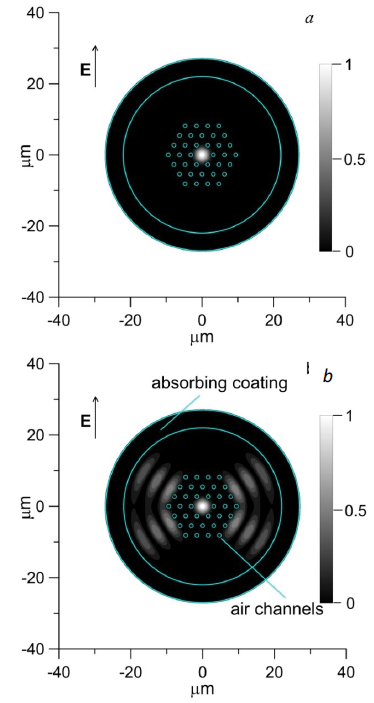
Figure 3: Optical densities of the adiabatic taper waist working mode related to the maxima of the loss at λ=1.279 µm (a) and λ=1.244µm (b) (see curve 7 in Figure 2b). Arrows E indicate the main orientation of the mode electric field vector.
1.2. Sensor applications
Since the electrodynamics properties of the PCF absorbing coating can be influenced by the environment, a change in parameters of the environment will lead to a modulation of the leaky mode propagation constants for the absorbing coating and, as a consequence, to the modulation of the fiber transmission in the vicinity of the resonance wavelengths. Figure 4 refers to the PCF taper with the polymer coating of thickness d=5μm, surrounded with water, studied in the previous section.
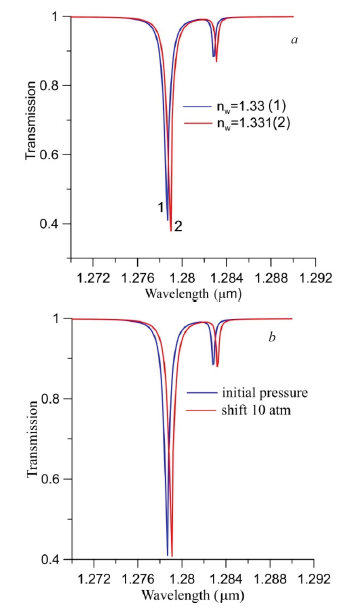
Figure 4: Shift of the adiabatic PCF taper transmission minima in dependence on change of refractive index (a) or pressure (b) in a surrounding liquid.
At calculation of a pressure sensor, we took into account, that a change in pressure results in changing the coating thickness Δd and also in the photo elastic shift Δnc of its refractive index. Both these factors influence the propagation constants of the coating leaky modes. According to the theory of elasticity [8], the relationship between the increment in a coating thickness and the increment in pressure ΔP in the environment is given by the formula

where B=Aw+d, E is the Young's modulus, σ is the Poisson's ratio for the coating. Photo elastic shift Δnc was estimated by the formula , where K is the Brewster’s coefficient. For butyl acrylate we used E=7·108 Pa, , K= 1/Pa. According to Figure 4, sensors of described before type with the absorbing polymer coating are well suited for testing parameters of liquids. Many different absorbing coatings for silica fibers are known this time [2, 3]. Our calculations have shown that the most of these coatings can be used in sensors of the considered type. However, the described effect of the leaky mode resonance coupling manifests itself in different ways, when low-refractive and high-refractive absorbing coatings are used. This confirmed by data presented in Figures 5 and 6. They refer to the coating of tin dioxide doped with antimony (7 weight percent), selectively adsorbing ammonia molecules from air. Calculations are performed for the adiabatic taper with the above parameters, but surrounded by air instead of water. The SnO2 coating thickness is 0.6 µm, its complex refractive 
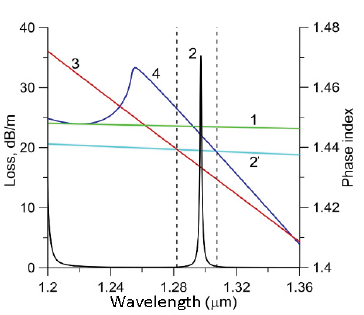
Figure 5: Spectral dependencies of mode propagation constants for the adiabatically tapered PCF with 2Aw=44μm and SnO2 coating surrounded with air. Curve designations are the same as in Figure 2a.
In comparison with the curve 7 in Figure 2b, the analogous dependency 2 in Figure 5 is less complicated. In the considered spectral range, it has only one loss peak refers to the direct coupling of the PCF fundamental mode with leaky coating modes. It was confirmed by the calculation of the fundamental PCF mode intensity distribution at the wavelength λ=1.297µm, corresponding to the maximum of the mode loss in Figure 5. This distribution is qualitatively the same as one in Figure 3a. Figure 6 illustrates the shift of the PCF transmission spectrum upon a deposition on the coating of an adsorption layer of ammonia molecules with a thickness of 1nm and the refractive index na=1.355.
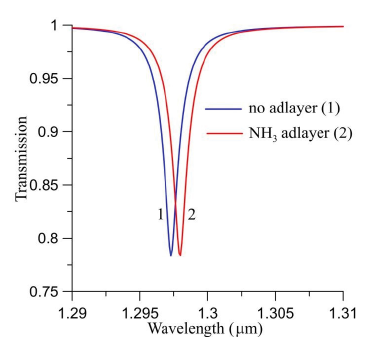
Figure 6: Shift of the adiabatic PCF taper transmission at formation of an adsorption layer of ammonia molecules on a surface of the SnO2 coating.
2. Conclusions
We report on a quasi-periodic spectral transmission of a single-mode photonic crystal fiber with absorbing thin-film coatings. Two mechanisms for implementation of such the transmission have been established. In the first one the leaky fundamental mode of the PCF is resonance coupled with leaky modes of the coating. This coupling leads to a resonance capture of energy of the fundamental PCF mode by the coating and the release of heat in it. The second mechanism is more complicated and can be observed in PCFs with sufficiently small cladding diameters that can be realized in a taper waist. It consists of a resonance coupling of the leaky fundamental PCF mode with cladding modes localized between air channels and the absorbing coating. In comparison with the last mechanism, the first one allows narrower spectral absorption bands to be realized. For this reason, it is more attractive for sensor applications. In our sensor examples of refractive index, pressure and ammonia molecules it is shown that a small modulation in refractive index and (or) the PCF absorbing coating thickness leads to a detectable modulation of the fiber transmission in the vicinity of resonance wavelengths.
Declarations
Acknowledgements
Sotsky A.B., Shilov A.V. and Sotskaya L. I. would like to thank a Byelorussian State Scientific Program ¨Photonics 1.3.03¨ for partially support of this work. The authors also would like to thank their colleagues Monzón-Hernandez, D., Kir´yanov, A.V., and Calixto S. for productive scientific cooperation.
Funding
Declared at acknowledgements.
Availability of data and materials
Data sharing is not applicable to this article as no datasets were generated.
Authors´ contributions
All authors contributed to the preparation, writing and reviewing of the manuscript. All authors have read and approved the final manuscript.
Competing interests
The authors declare that they have no competing interests.
References
- Sotsky AB, Sotskaya LI, Minkovich VP, et al. Mode attenuation in microstructured optical fibers with absorbing coating. Tech. Phys 54 (2009): 865-873.
- Del Villar I, Arregui FJ, Zamarreño CR, et al. Optical sensors based on lossy-mode resonances. Sensors Actuators B Chem 240 (2017): 174-185.
- Ozcariz A, Ruiz-Zamarreño C, Arregui FJ. A Comprehensive Review: Materials for the fabrication of optical fiber refractometers based on lossy mode resonance. Sensors 20 (2020): 1-23.
- Cardenas-Sevilla GA, Monzon-Hernandez D, Minkovich VP. Demonstration of an all-fiber band-rejection filter based on a tapered photonic crystal fiber. Appl Phys Express 5 (2012): 022502.
- Minkovich VP, Monzón-Hernández D, Villatoro J, et al. Modeling of holey fiber tapers with selective transmission for sensor applications. J. Lightw. Technol 24 (2006): 4319-4328.
- Sotsky AB. Theory of optical waveguide elements. Mogilev State A. Kuleshov University, Mogilev (2011): 422-427.
- Sotsky AB, Steingart LM, Jackson JH, et al. Prism excitation of leaky modes of thin films. Technical Physics 58 (2013): 1651-1660.
- Landau LD, Lifshitz EM, Kosevich AM, et al. Theory of Elasticity 7 (1986): 30-39.

 Impact Factor: * 1.2
Impact Factor: * 1.2 Acceptance Rate: 78.36%
Acceptance Rate: 78.36%  Time to first decision: 10.4 days
Time to first decision: 10.4 days  Time from article received to acceptance: 2-3 weeks
Time from article received to acceptance: 2-3 weeks 